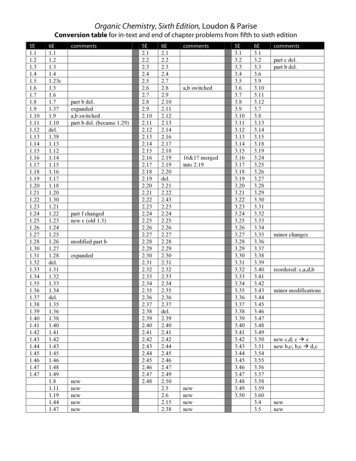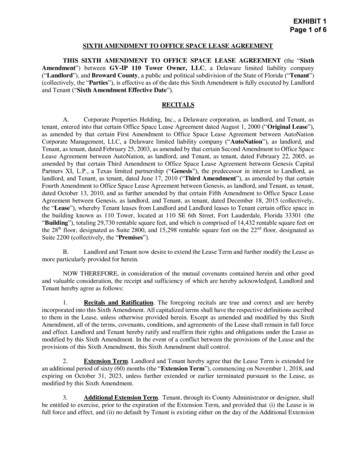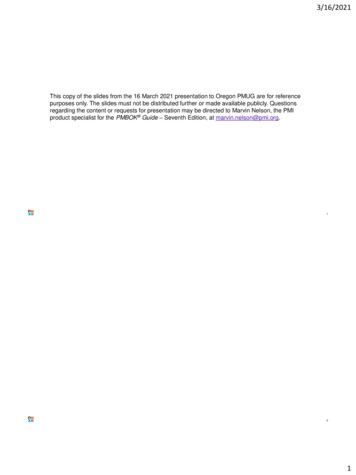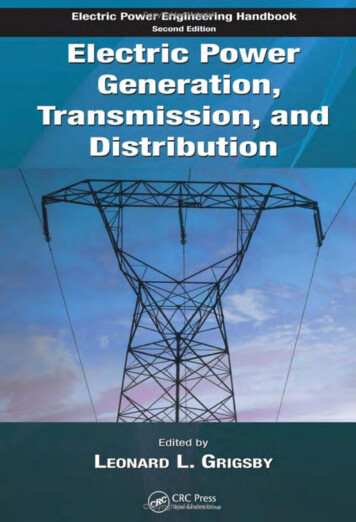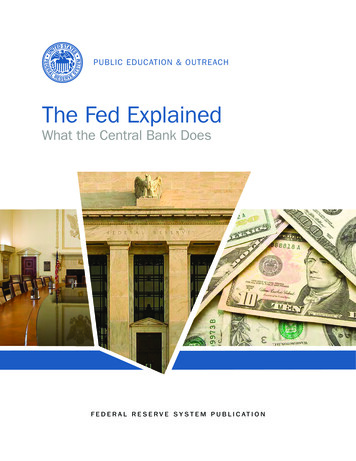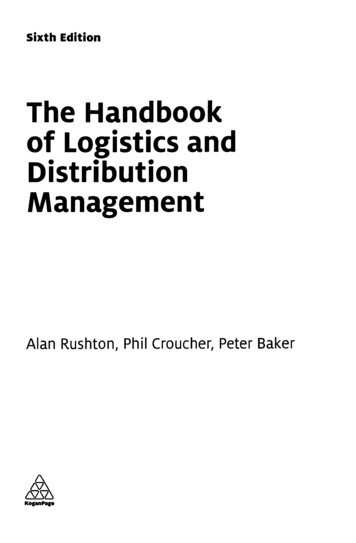
Transcription
Sixth EditionTheofHandbookLogistics andDistributionManagementAlan Rushton, Phil Croucher, Peter BakerAKoganPag«
CONTENTSList of figures xviiList of tables xxviiAbout the authors xxviiiPreface xxxiPART ONE Concepts of logistics and distribution 101Introduction to logistics and distribution 3Introduction 3Scope and definition 4Historical perspective 7Importance of logistics and distribution 10Logistics and supply chain structure 14Summary 1602Integrated logistics and the supply chajn 17Introduction 17The total logistics concept 17Flanning for logistics 20The financial impact of logistics 24Globalization and Integration 25Integrated systems 26Competitive advantage through logistics 28Logistics and supply chain management 30Summary 3103Customer Service and logistics 33Introduction 33The importance of customer Service 34The components of logistics-related customer Service 36Two conceptual models of Service quality 38Developing a customer Service policy 41Levels of customer Service 49Measuring customer Service 50
Service level agreements 52The customer Service explosionSummary 55Channels of distribution5557Introduction 57Physical distribution channel types and structures 58Channel selection 62Outsourcing Channels 66Summary 70Key issues and challenges for logistics and thesupply chain 71Introduction 71The externa! environment 72Manufacturing and supply 76Logistics and distribution 80Retailing 89The consumer 94Summary 98PART TWO06Flanning for logistics 99Flanning framework for logistics 101Introduction 101Pressures for change 101Strategie planning overview 103Logistics design strategy 106Product characteristics 109The product life cycle 112Packaging 113Unit loads 114Summary 11507Logistics processes 117Introduction 117The importance of logistics processes 117Logistics process types and categories 119
An approach to process design and redesign 123Tools and techniques 124Summary 13108Supply chain segmentation 133Introduction 133Product segmentation 133Demand and supply segmentation 135Marketing segmentation 137Combined segmentation frameworks 138Two-tier supply chains 139Implementation 140Summary 14109Logistics costs and trade off analysis 143Introduction 143The role of distribution centres and warehouses 143Cost relationships 145Summary 15310Logistics network planning 155Introduction 155A planned approach or methodology 156Initial analysis and option definition 158Logistics modelling: logistics options analysis 164Evaluate results, develop Implementation plan 168Practica! considerations for site search 170Summary 17211Logistics management and Organization 173Introduction 173Logistics relationships with other corporate functions 173Logistics organizational structures 175Organizational Integration 177The role of the logistics or distribution manager 180Payment schemes 182The selection of temporary staff and assets 187Summary 189
12Omnichannel fulfilment 191Introduction 191lssues 192Food retailing 194Non-food retailing 196Summary 19913Manufacturing logistics201Introduction 201Typology of Operations 202Manufacturing resource planning (MRPII) 208Material requirements planning (MRP) 208The MRP system 209Flexible fulfilment (postponement) 213The effects on distribution activities 213Future developments 214Summary 215PART THREE Procurement, inventory and demandforecasting 21714Procurement and supply 219Introduction 219The procurement cycle 220The scope of procurement 221Setting the procurement objectives 221Managing the suppliers 229Expediting 232Procurement Performance measures 232Collaborative planning, forecasting and replenishment 233Factory gate pricing 234E-procurement 234Corruption 236Summary 23615Inventory: the basic concepts 237Introduction 237The need to hold stocks 237
Types of stockholding/inventory 239Stockholding policy implications for other logistics functions 241Inventory costs 243Reasons for rising inventory costs 244Inventory replenishment systems 245The reorder point and safety stock 247The bullwhip or Forrester effect 249The economic order quantity 251Summary 25516Inventory and the supply chain257Introduction 257Problems with traditional approaches to inventory planning 257Different inventory requirements 258The lead-time gap 261Inventory and time 262Analysing time and inventory 264Summary 26617Inventory planning and demand forecasting 267Introduction 267Inventory planning horizons 268Demand forecasting 268Qualitative forecasting methods 270Quantitative forecasting methods 270Inventory planning for manufacturing 278Inventory planning for retailing 280Summary 287PART FOUR Warehousing and storage 28918Principles of warehousing 291Introduction 291The role of warehouses 292Warehouse Operations 294Costs 298Packaging and unit loads 298Summary 300
19Storage and handling systems (palletized) 301Introduction 301Fallet movement 301Fallet stacking 304Palletized storage 309Palletized storage - comparison of systems 323Rack safety 324Summary 32620Storage and handling systems (non-palletized) 327Introduction 327Small item storage systems 328Truck attachments 335Long loads 336Cranes 339Conveyors 339Automated guided vehicles 341Hanging garment systems 341Summary 34221Order picking and packing343Introduction 343Order picking concepts 343Order picking equipment 345Sortation 356Picking area layout 359Pick face size 359Slotting 360Pick routes 360Information in order picking 361E-fulfilment 363Picking productivity 365Replenishment 366Packing 367Summary 36822Receiving and dispatch 369Introduction 369Receiving processes 369
Dispatch processes 371Cross-docking 371Returned goods 373Receiving and dispatch equipment 374Layouts 378Yard management 381Summary 38223Warehouse design 383Introduction 383Strategie issues affecting warehousing 383Design procedure 384Design of specialist warehouses 402Summary 40424Warehouse management and Information 407Introduction 407Operational management 407Information technology 412Summary 419PART FiVE Freighttransport 42125International logistics: modal choice 423Introduction 423Relative importance of the main modes of freight transport 424Method of selection 426Operational factors 427Transport mode characteristics 431Consignment factors 436Cost and Service requirements 437Aspects of international trade 438Summary 44426Maritime transport 447Introduction 447Structure of the industry 447Common shipping terms 449
Surcharges 453Documentation 455Vessel Classification and certification 456Common ship types and their cargoes 458Ports and cargo handling 464Other factors 465Summary 46827Air transport469Introduction 469Structure of the industry 469Air cargo handling 471Types of air freighter 474Documentation 476Air hubs and spokes 477Air freight pricing 478Air cargo security 481Summary 48328Rail and intermodal transport485Introduction 485Intermodal equipment 486Intermodal vehicles 494Intermodal infrastructure 501Mode shift grant schemes 503Rail transport 504Summary 51029Road freight transport: vehide selection 513Introduction 513Main vehicle types 514Types of Operation 516Load types and characteristics 524Main types of vehicle body 527The wider implications of vehicle selection 535Vehicle acquisition 536Summary 537
30Road freight transport: vehicle costing 539Introduction 539Reasons for the use of road freight transport vehicle costing 539Road transport costing - key Information required 541Vehicle Standing costs 543Vehicle running costs 548Overhead costs 550Costing the total transport Operation 551Whole life costing 552Vehicle cost comparisons 555Zero-based Budgets 556Direct product profitability 557Summary 55931Road freight transport: planning and resourcing 561Introduction 561Key planning aspects of road freight transport 562Main types of road freight transport 563Transport resources: planning and operational requirements andoptimization 565Key issues concerning vehicle utilization 568Fleet management 572Other road freight transport information systems applications:telematics 574Summary 57532Road freight transport: routeing and scheduling 577Introduction 577Vehicle routeing and scheduling issues 578Manual methods of vehicle routeing and scheduling 586Computer routeing and scheduling 594Summary 59833International freight forwarding 601Introduction 601The role of the freight forwarder 602Specialized services 604Documentation 608
Cargo insurance 614Project logistics 617Common terms explainedSummary 621619PART six Outsourcing logistics 62334Outsourcing: Operations and services 625Introduction 625Breadth of outsourcing 626Operations provided by third-party companiesCategories of services available 633Specialist value added services 640Summary 64435627Outsourcing: decision criteria 645Introduction 645Different types of operation: dedicated or multi-user?Drivers and drawbacks of outsourcing logistics 649Critical factors of choice 655Summary 65736Outsourcing: the selection process 659Introduction 659Approach 659Detailed steps 661Summary 68337Outsourcing: management 685Introduction 685The need for management 686Managing the relationship 687Implementation planning 690Monitoring an outsourced logistics operation 692Summary 696645
PART SEVEN Operational management 69938Cost and Performance monitoring 701Introduction 701Why monitor? 703Different approaches to cost and Performance monitoring 704What to measure against? 710A logistics operational planning and control system 715Good practice 716Influencing factors 720Detailed metrics and KPIs 721The presentation of metrics 725Summary 72739Benchmarking 729Introduction 729Why should an Organization engage in benchmarking? 730How to conduct a benchmarking exercise 731Formal benchmarking systems 736Benchmarking distribution Operations 737Summary 74740Information and communication technology in thesupply chain 749Introduction 749Basic communication 750Supply chain planning 752Big data 754Warehousing 755Inventory 756Transport 756Other applications 758Trading using the internet - e-commerce 761Summary 76441Security and safety 765Introduction 765International security measures 765
Strategie security measures 767Tactical security measures 769Safety in the distribution centre and warehouseSummary 78142778Logistics and the environment 783Introduction 783The European Union and environmental legislationLogistics and environmental best practice 790Alternative fuels 803Summary 80743Humanitarian logistics 809Introduction 809Key differences 810Key terms 812Performance measurement 816Pre-positioning of resources 818Assessment and planning 819The Cluster approach 820Distribution 822Summary 822Further reading 823R eferences 825Acronyms and abbreviations 829Index 839784
Scope and definition 4 Historical perspective 7 Importance of logistics and distribution 10 Logistics and supply chain structure 14 . The role of the logistics or distribution manager 180 Payment schemes 182 The selection of temporary staff and assets 187 Summary 189 . 12 Omnichannel fulfilment 191





